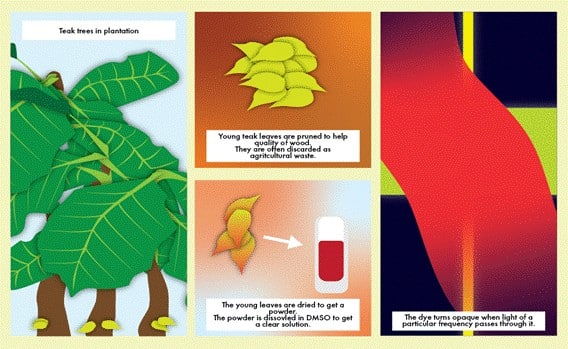Scientists Discover New Use for Teak Leaves

Teak leaf extract may hold the key to protecting human eyes and sensitive optical devices from the harmful effects of high-power laser radiation. Researchers at the Raman Research Institute (RRI) in India have discovered that the extract, derived from the often-discarded leaves of the teak tree, possesses unique nonlinear optical properties. This breakthrough could pave the way for eco-friendly alternatives to synthetic materials currently used in laser safety applications across medical, military, and industrial fields.
Innovative Use of Teak Leaves
Scientists at RRI have turned their attention to the teak tree (Tectona grandis L.f), specifically its leaves, which are typically considered agricultural waste. These leaves are rich in anthocyanins, natural pigments that give them a reddish-brown color. The research team identified the nonlinear optical (NLO) properties of these pigments, which allow them to interact with light in a unique way. This discovery, published in the Journal of Photochemistry and Photobiology A: Chemistry, highlights the potential of teak leaf extract as a sustainable and non-toxic alternative to synthetic optical materials, which are often expensive and environmentally harmful.
Beryl C, a DST Women Scientist at RRI, emphasized the significance of this research. She stated that the team aimed to explore the potential of teak leaf extract as a biodegradable and economically viable substitute for synthetic dyes in nonlinear optics. By utilizing this underexploited natural resource, they not only contribute to waste utilization but also promote the development of sustainable photonic materials that can rival conventional synthetic options.
Extraction and Testing Process
To harness the optical properties of teak leaves, the RRI team employed a systematic approach. They dried and powdered the leaves, then soaked the powder in solvents to extract a vibrant reddish-brown liquid dye. This dye was subjected to rigorous testing using green laser light at varying power levels. The experiments revealed that the dye exhibited reverse saturable absorption (RSA), meaning it absorbed more light as the intensity increased. This characteristic is crucial for developing effective laser safety gear.
Advanced techniques such as Z-Scan and Spatial Self-Phase Modulation (SSPM) were utilized to analyze the dye’s behavior under laser exposure. The findings indicate that the teak leaf extract could serve as a natural optical limiter, providing a safer alternative to traditional materials used in laser protection.
Environmental and Practical Implications
The discovery of an eco-friendly optical material like teak leaf extract is significant for the future of photonic technologies. Traditional optical limiters often rely on costly materials such as graphene and metal nanoparticles, which can be detrimental to the environment due to their complex synthesis processes. In contrast, teak leaf dye is readily available and offers a sustainable solution for laser safety applications.
This research opens new avenues for creating modern, environmentally friendly laser protective equipment, including safety goggles, optical sensor shields, and laser-resistant coatings. Future studies may focus on enhancing the stability of the dye for long-term use and its integration into commercial photonic devices. As advancements continue, this natural dye could play a vital role in the development of green optical technologies, reducing the risk of laser-induced damage and contributing to a safer, more sustainable technological landscape.
Observer Voice is the one stop site for National, International news, Sports, Editor’s Choice, Art/culture contents, Quotes and much more. We also cover historical contents. Historical contents includes World History, Indian History, and what happened today. The website also covers Entertainment across the India and World.

